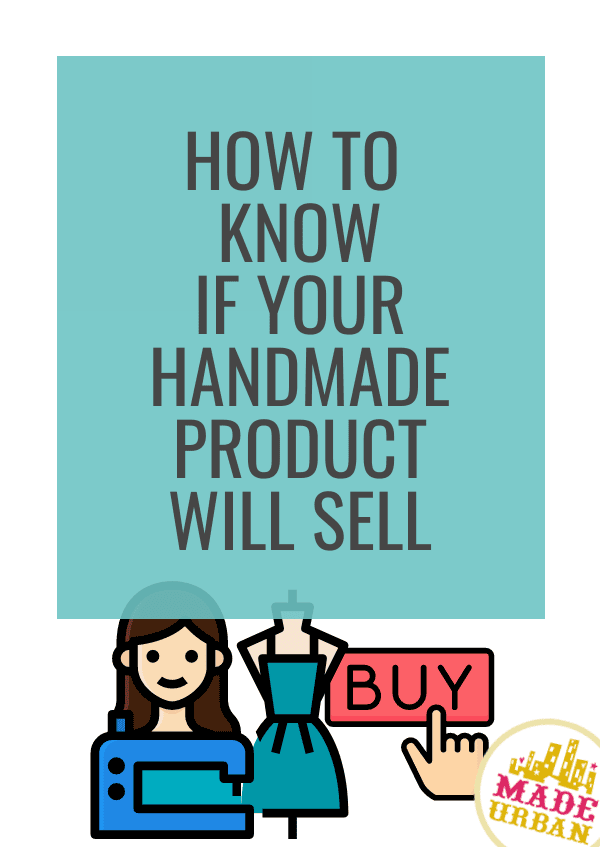How to Know if your Handmade Product will Sell
The hard part is; you’ll never know 100% what people will and won’t buy until you put it out there.
But….you can increase your chances of creating a handmade product that sells and save costs along the way by doing research and working off facts, not guesses.
Let’s assume you’re in the dream stage of your new product. You have an idea, have figured out several details but haven’t actually begun making any.
You’re in the safe zone right now; not a lot of money has been put into this new product idea and you have very little risk at this point.
Follow these 3 steps to continue to keep risk low.
STEP 1: Start with a handmade product that solves a problem or appeals to a passion
Every great product solves some sort of a problem or feeds a passion.
Which problem is your new product solving, and how will it improve your customers’ lives?
If someone has already purchased from you, why do they need this new product?
Think of a passion as almost an obsession of your customers. They spend their time discussing, reading or asking questions about the topic. It may be:
- a certain style of fashion
- skiing
- cats
- saving the environment
- following a specific diet
- etc.
If you can’t think of a problem your new product solves or a passion it appeals to, you may want to go back to the drawing board.
>> Think about the problem you wish your products would solve or take a trip to your customer’s mind for a second. What do they wish your products would solve?
>> Or consider the Facebook groups your customers join or the pages they follow.
>> What about the magazines and blogs they read?
>> Or the events they attend.
Exploring your customers’ interests outside of the products they buy may help you find a passion.
Once you find that passion, you can work your products into it.
People don’t just buy for the sake of buying; there’s a reason behind every purchase.
Make sure your new product gives consumers a reason to buy it.
STEP 2: Gather info
There are several ways you can look for proof of concept.
1) Check your stats
If you’ve already built a customer base, study your traffic/engagement/sales stats to ensure your new product aligns with what’s been popular for you in the past.
Check your:
- Google Analytics – which product pages are visited the most on your site? Which pages do visitors stay on the longest? These stats will indicate which products your shoppers are most drawn to. If your new product shares commonalities with those products, there’s a good chance it will be popular too.
- Social media stats – which posts tend to get the most likes, comments and clicks? This may be an indication that your audience wants to see more of the same.
- Sales – which product(s) did you sell the most of in past months? If there are several top sellers, look for commonalities. Do your popular products all have the same color, style, or function? Does your new product share those commonalities?
2) Send a newsletter
If you have a newsletter list, send an email asking your subscribers if they’d be interested in providing you with feedback.
The key is to consider what exactly you want to know about the product and ask specific questions to draw those answers out of people.
Simply sending a photo of a new product and asking if people like it, won’t get you valuable information.
You could ask:
- What colors would you prefer to see this in?
- What type of details do you look for when purchasing a product like this?
- What objections might you have to buying this product?
People are busy so keep it short and simple. I love typform for gathering answers. Use their free version, add your branding and analyze your results in one spot. You could even sweeten the pot by offering something to those who do respond. Perhaps a coupon code they can use on a future purchase would encourage more people to reply.
3) Check popular searches
You can use a keyword tool, which will tell you (approximately) how many people search a term online each month and how many websites are competing for that term.
Or you can look at auto-suggestions search engines offer. This is a less accurate way to know if an item is popular, but it can give some indication.
Let’s say I’m thinking of making a “bow scrunchie”. I would choose a search engine, such as Google, and begin typing my phrase. I’d enter “bow” and see which auto-suggestions popular below the search bar.
“Bow” is a little broad so I’d start typing “scrunchie” stopping after each letter to see if my completed term appears in the suggestions below.
When I type “bow sc”, “bow scrunchie” and “bow scrunchie pattern” appear in the auto-suggestions below.
That’s a good sign that there’s demand for my new product.
If I typed out the full word and nothing populated below, it may indicate there aren’t many people searching for that product.
You can try this on other platforms your target market uses (e.g. Etsy’s search bar, Pinterest’s search bar, etc.)
4) Find proof of an audience
If you’re just starting out and don’t know your target market/have an existing customer base, make sure you know where to find them.
For example, if I’m making a “yoga scrunchie”, I know exactly where to find people who will be interested in my product:
- Yoga studios (I could reach out to local yoga studios and see if they would be interested in carrying my scrunchies)
- Yoga magazines and blogs (I could pitch my product to magazines and blogs in hopes they’ll feature it, or even pay for an ad in their publication)
- Yoga influencers (I could send some free scrunchies to yoga influencers in hopes of them mentioning them to their followers or pay for a feature)
- Etc.
On the other hand, if I decided to make regular scrunchies in a wide variety of colors, materials, and prints, I don’t have a clear path to my customers.
I can still list them on Etsy or set up at a craft show, but I have to wait and hope shoppers find me. It’s beneficial when you can find them.
5) Check out competitors
Etsy is a good place to find proof of sales for a particular product.
How to:
- Enter your product name into the search bar at the top of Etsy and click Search.
- Look for a product similar to the one you plan to sell.
- Check the reviews
- Look for reviews on the specific product. The more that show up, the more sales that product received. Keep in mind, not everyone who buys writes a review. So if there are lots of reviews for a particular product, it likely means there were even more sales. And if there are no reviews, it doesn’t necessarily mean there have been no sales.
- Read what people specifically loved about their product. You’re not looking to copy their product. You’re just looking for proof that consumers are interested in the product features you’ll be offering.
- Note whether reviews were high, if they were good, bad or great and any specific mentions of liked/disliked features.
- Head to their shop and check the number of sales (if displayed) and “On Etsy Since”. A high number of sales over a short period of time is a good indication of a popular product.
- Note if sales are high or low for the amount of time the seller has been on Etsy.
Just because sales or reviews are low for a product, doesn’t necessarily mean it won’t sell for you. The seller may not promote their Etsy shop or they may be missing a few key elements that help a handmade product sell. Check:
- Photography – photos should look professional and show details shoppers are interested in.
- Titles & descriptions – titles should use keywords consumers commonly search. Naming my yoga scrunchie “the Jane scrunchie” will not help my SEO (unless it’s a popular product, no one is searching for “Jane scrunchies”.
- Pricing – too low and it will turn shoppers off and make them wonder why their products are priced so much lower than others. Too high, without explaining why, will also drive shoppers away.
STEP 3: Sell a prototype
Instead of creating a ton of stock, create one prototype. Make it look awesome, photograph it well and put it out there. Post it to your website, social media pages and display your prototype at your next craft show or event.
You can make more product as sales come in, or even take pre-sales. Consumers who buy before the product is ready may get a perk in the form of a discount. You make less profit but you lower your risk.
Making an item one at a time does consume more production hours than creating product in bulk. But you’ll save time and money by not having to spend it on materials and production that you may or may not see a return on.
Stay in this test phase for as long as you feel is needed to prove whether your handmade product will sell or not.
If you want more info on creating products that sell themselves and require very little marketing efforts or you’d like more details on how to find your audience, download THE SUCCESSFUL INTROVERT.


Hey, I’m Erin 🙂 I write about small business and craft show techniques I’ve learned from being a small business owner for almost 2 decades, selling at dozens of craft shows, and earning a diploma in Visual Communication Design. I hope you find my advice helpful!
